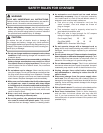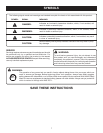
14
OPERATION
Keep the unit at full speed the entire time you are
cutting.
For second and final cuts (from top of limb or branch),
hold the front cutting guide against the limb being cut.
This will help steady the limb and make it easier to cut.
Allow the blade to cut for you; exert only light downward
pressure. If you force the cut, damage to the blade or unit
can result.
Release the trigger as soon as the cut is completed,
allowing the unit to stop.
LIMBING AND PRUNING
See Figures 13 - 14.
This unit is designed for trimming small branches and limbs
up to 4 in. in diameter.
Plan the cut carefully. Be aware of the direction in which
the branch will fall.
Branches may fall in unexpected directions. Do not stand
directly under the branch being cut.
The pole pruner should typically be positioned at an angle
of 60° or less, depending on the specific situation.
As the boom-to-ground angle of the unit increases, the
difficulty of making the first cut (from the underside of
limb) increases. Failure to keep the tool at the correct
angle can result in the blade binding and becoming
pinched or trapped in the limb. If this should happen:
• Stop the unit and remove the battery pack.
• Remove the blade retaining screw, using the hex
key supplied, then remove the unit from the trapped
blade.
• Lift the limb while holding the blade. This should
release the “pinch” and free the blade.
• If the blade or pole pruner is still trapped, call a
professional for assistance.
The long reach of the unit allows the operator to prune
branches or limbs that are normally out of reach.
Long branches should be removed in several stages.
Cut lower branches first to allow the top branches more
room to fall.
Work slowly, keeping both hands on the pole pruner with
a firm grip. Maintain secure footing and balance.
Keep the tree between you and the blade while limbing.
Cut from the side of the tree opposite the branch you are
cutting.
Do not cut from a ladder. This is extremely dangerous.
Leave this operation for professionals.
Do not use for felling or bucking.
When pruning trees, it is important not to make the flush
cut next to the main limb or trunk until you have cut off
CUTTING GUIDE
Fig. 12
Fig. 13
60° MAXIMUM
(
)
Fig. 14
( )
the limb further out to reduce the weight. This prevents
stripping the bark from the main member. Underbuck the
branch 1/4-way through for your first cut. Your second cut
should overbuck to drop the branch off. Now make your
final cut smoothly and neatly against the main member
so the bark will grow back to seal the wound.
To prevent electrocution, do not operate within 50 feet
of overhead electrical lines.
Keep all bystanders at least 50 ft. away.
Never climb into a tree to limb or prune. Do not stand on
ladders, platforms, or a log, or in any position which can
cause you to lose your balance or control of the unit.


















